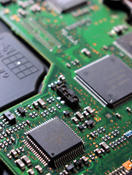What is a PCB Silkscreen on Printed Circuit Boards?
Were you one of those kids who loved to take apart every electronic thing in your house? If so, you’ve probably pulled out your fair share of green printed circuit boards. It’s cool to hold them and to run your fingers over all their little metallic bumps. When you brought them close to your eye, you could even see little white designs, numbers, and letters drawn on them. What is this mysterious language? It’s called the PCB silkscreen.
The PCB Silkscreen
Silkscreen is the white and human readable letters, normally used to identify components, test points, PCB and PCBA part numbers, warning symbols, company logos, date codes and manufacturer marks. Silk-screening requires specially formulated inks. The standard color is white, but you can also select red, blue, black, yellow, etc. Most silkscreens are written in white ink, because it is easy to see against the green solder-mask, but silkscreens can actually be any color. If you take apart enough electronics, you are bound to find PCBs with gray, red, and even blue silkscreens.
Adding the silkscreen layer onto a printed circuit board is the final step in the fabrication process. These shapes, numbers, and letters really aren’t some new language. They act as basically an instruction manual, telling workers how to assemble the board as part of the larger device. They can also communicate the function of each of the pins. Screen-printing is done when the boards are still penalized prior to the application of the final finish or routing/v-scoring.
PCB layout designers sometimes forget to double-check their silk screen layers before sending designs to PCB fabrication. Designers should avoid putting ident over component pads, they should avoid using excessively tiny text and should allow for registration tolerances.




